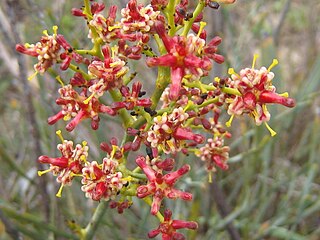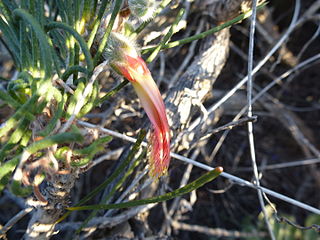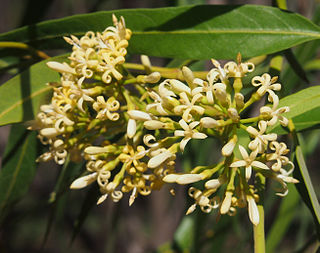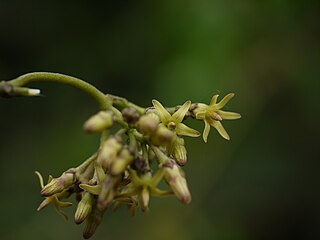Banksia densa is a species of column-like shrub that is endemic to Western Australia. It has deeply serrated to pinnatifid leaves, creamy yellow flowers in heads of up to seventy-five, and hairy follicles.

Hakea orthorrhyncha, commonly known as bird beak hakea, is a shrub which is endemic to the Murchison River area of Western Australia.

Eucalyptus macrorhyncha, commonly known as the red stringybark, is a species of medium-sized tree that is endemic to eastern Australia. It has rough, stringy, grey to brown bark, lance-shaped adult leaves, flower buds in groups of between seven and eleven, white flowers and hemispherical fruit.

Eucalyptus grossa, commonly known as coarse-leaved mallee, is a species of mallee or rarely a straggly tree, that is endemic to Western Australia. It has rough, fibrous bark on the trunk and all but the thinnest branches, broadly lance-shaped to egg-shaped adult leaves, flower buds in groups of seven, yellowish green flowers and cup-shaped to cylindrical fruit.

Stirlingia, commonly known as blueboy, is a genus of 7 species in the family Proteaceae, all of which are endemic to Western Australia.

Verticordia helichrysantha, commonly known as coast featherflower or Barrens featherflower, is a flowering plant in the myrtle family, Myrtaceae and is endemic to the south-west of Western Australia. It is a small, woody, open-branched shrub with crowded, linear leaves and small yellow flowers from May to September.

The flora of Western Australia comprises 10,252 published native vascular plant species and a further 1,245 unpublished species. They occur within 1,543 genera from 211 families; there are also 1,276 naturalised alien or invasive plant species more commonly known as weeds. There are an estimated 150,000 cryptogam species or nonvascular plants which include lichens, and fungi although only 1,786 species have been published, with 948 algae and 672 lichen the majority.

Parsonsia straminea, commonly known as common silkpod or monkey rope, is a woody vine of the dogbane family, Apocynaceae. It occurs in the states of New South Wales and Queensland in Australia.

Acanthocladium dockeri is a critically endangered species of the family Asteraceae that belongs to the monotypic genus Acanthocladium. It is commonly known as spiny everlasting or spiny daisy. It is native to Australia, and is found around the South Australian town of Laura.

Adenanthos macropodianus, commonly known as gland flower, or Kangaroo Island gland flower, is a species of shrub in the family Proteaceae. It is endemic to Kangaroo Island in South Australia. First published as a variety of A. sericeus in 1870, it was promoted to species rank in 1978.

Adenanthos detmoldii, commonly known as Scott River jugflower or yellow jugflower, is a species of shrub in the family Proteaceae. It is endemic to the south-west of Western Australia.

Calothamnus chrysanthereus , commonly known as claw flower is a plant in the myrtle family, Myrtaceae and is endemic to the south-west of Western Australia. It is an erect shrub with needle-shaped leaves crowded on the ends of the branches and bright red flowers in spring.

Adenanthos sect. Eurylaema is a taxonomic section of the flowering plant genus Adenanthos (Proteaceae). It comprises four species, all of which are endemic to southwest Western Australia.
Macropteranthes kekwickii, commonly known as bullwaddy, is a species of woody tree or shrub native to the Northern Territory in Australia.

Parsonsia eucalyptophylla, whose common names are gargaloo and monkey vine, is a woody vine in the family Apocynaceae. It is native to the east coast states of Australia.
The botanical provinces of Western Australia delineate "natural" phytogeographic regions of WA, based on climate and types of vegetation. John Stanley Beard, in "Plant Life of Western Australia" (p. 29-37) gives a short history of the various mappings.

Billardiera fraseri is a species of plant in the family, Pittosporaceae, which is endemic to Western Australia.

Parsonsia alboflavescens is a woody vine of the family Apocynaceae, found from tropical and subtropical Asia to Northern Australia. In the Northern Territory of Australia, where it occurs in Arnhem Land, it has been declared "near threatened".

Scaevola parvifolia is an erect, many stemmed perennial in the family Goodeniaceae, which is native to Western Australia, the Northern Territory, Queensland and South Australia. It grows to a height of 0.6 m, and its blue-purple flowers may be seen from March to October.

Leucopogon plumuliflorus is a shrub in the family Ericaceae. It is endemic to Western Australia.


















